|
|
 |
Where next after Venice (and Florence)? Trips to Padua and Verona (which both came under Venetian rule in 1405) suggested that they were more than worthy, and that with works by Bellini, Titian and the Tintorettos in evidence there's going to be plenty of connections, I thought. Well, it didn't quite turn out that way. Padua and Venice are more connected by history than art - the Republic wrested the place from the Carrara and ran things with a light hand for almost 400 years. But early Titian frescoes, a couple of Tiepolos and odd altarpieces by the likes of Palma Giovane and Bonifacio de 'Pitati are about the size of the art incursions. Giusto and Altichiero are the locals who come closest to emulating Giotto. The lesser known and later locals do not provide the surprises and joys of the likes of the Brusasorci, Badile and Morone, for example, in Verona. But fans of fresco are guaranteed satisfaction in a variety of venues. None of the churches charge entry, but the Duomo baptistery and some scuole and oratorios charge a few euros, with some churches now open by volunteers courtesy of Legambiente.
These five churches are the best, I think, |
|
page 1 |
on page 2 |
|
The word duomo comes from the Latin domus, meaning the house of the Lord. So nothing to do with domes. History The first church on this site, traditionally said to date from the 7th century, was destroyed by fire during the Hungarian invasion of 899 and rebuilt and consecrated on 29th December 1075 by Bishop Ulderico. This church was badly damaged by the earthquake on the 3rd of January 1117 and rebuilt in Romanesque style, in the 1120s, this church can be seen in Giusto de' Menabuoi's frescoes in the Baptistery. Another church was built by Bishop Stephen da Carrara in 1400, the previous one having fallen down. This one must itself also have been poorly constructed because plans were made for a new church in 1524. This, the current cathedral, was designed by Andrea della Valle and Agostino Righetto, reflecting the design of earlier Paduan churches. Work began in 1547, but was only completed in 1754, with the façade remaining unfinished. Paduans are said to have once boasted that the plans for this church supplied by Sansovino were rejected in favour of those commissioned from Michelengelo, but the fact that these plans were also ignored is evident from the church's eventual form. Damaged during a Royal Air Force bombing raid, targeting the railway marshalling yards, on 22nd March 1944. Interior The key word is huge - the aisles, with their immense chunky pillars, supporting oversized capitals, which separate them from the nave which has two cupolas over it, the side chapels, which are so deep they might be extra transepts, except that the actual transepts are even bigger with enormous altars at each end. Another appropriate word is 'dull'. 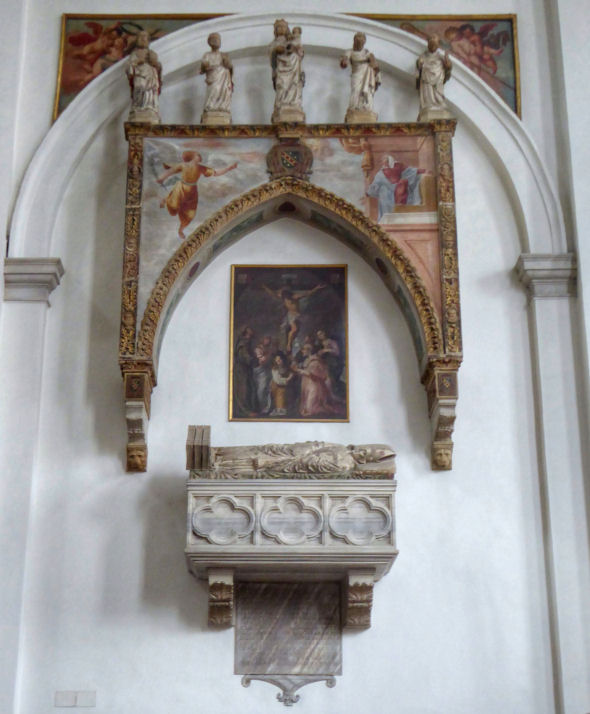 Art ArtNo labels on the paintings and no guidebook available. The paintings in here are all 18th-century or newer. The second and third (deeper) chapels on the left have altarpieces by Pietro Damini - Saint Jerome in the Desert with A Donor and a Crucifixion with Mary Magdalene and Catherine of Alexandria. The latter is the Chapel of Gregory Barbarigo, a 17th century Bishop of Padua, who is himself lying behind a glass panel in the altar, which is the work of Giorgio Massari. The row of dark bronze busts are of the patron saints of Padua - Daniel, Justina, Anthony and Prosdocimo. The next chapel has an unobjectionable Virgin and Child with Saints... with a curly-haired baby John the Baptist, of 1716 by Gian Antonio Pellegrini. The third chapel on the right has a dark and distant Virgin and Child with Saints attributed to Padovanino. Reports of paintings by Stefano dell'Azare, Tiepolo, and Paris Bordone could not be confirmed. Ditto a Virgin previously wrongly ascribed to 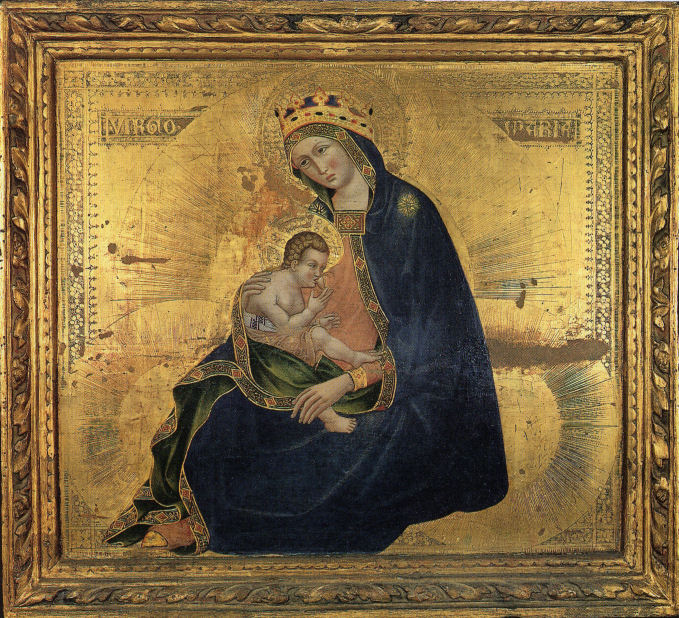 Giotto
- it was as a Giotto
that Petrarch bequeathed it to his friend Francesco da Carrara. Giotto
- it was as a Giotto
that Petrarch bequeathed it to his friend Francesco da Carrara.
A Byzantine-style Virgin and Child also mentioned might be the one read about in reliable reports of a 17th-century copy of a late 13th-century Virgin and Child, documented as used every year in a Christmas mystery play here. I have since also read about three works by Nicoletto Semitecolo in the sacristy here. Two panels depict scenes from the Life of Saint Sebastian and one is a Byzantine-looking gold-background Virgin and Child (see right). The transept has, as well as many tombs, a number of 18th-century-looking canvases too high to see. As does the choir. There are nasty melting-looking modern sculpture figures on the steps up to the presbytery, which has carved walnut stalls by Filippo Parodi, a pupil of Bernini who was also responsible for the very baroque reliquary chapel in the Santo. Even the crypt is uninteresting.
Lost art |
|
|
|
|
||
|
History |
|
|
|
Beato Antonio Pellegrino |
||
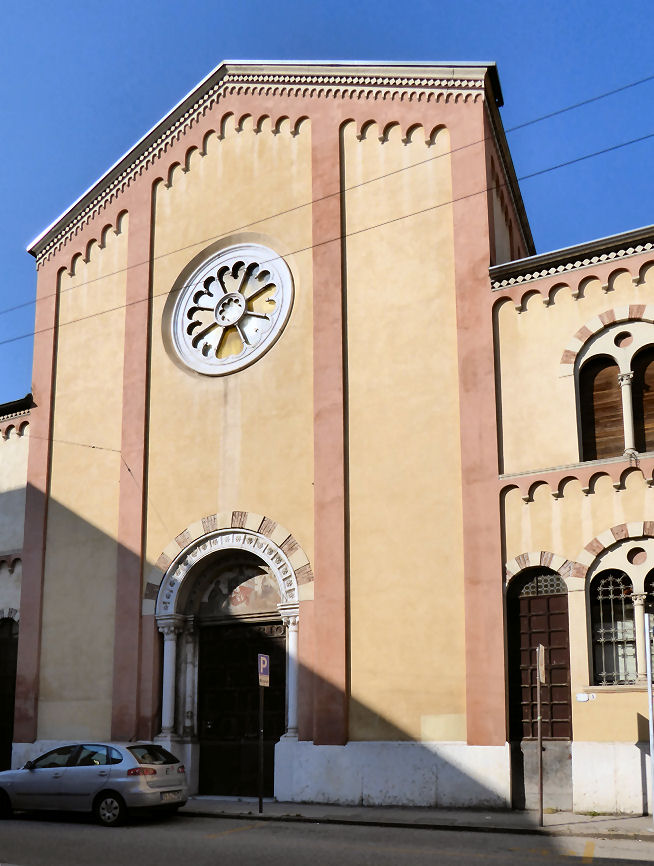
|
 History HistoryTradition puts a church here as early as the 4th century, but a documented mention of a church built over a necropolis is dated to the 9th March 1147, with monks from a Benedictine Monastery officiating here from 1177. That complex had become seriously dilapidated by the 16th century, but it wasn't until the years 1657-66 that the church was rebuilt to an aisleless Latin cross plan to plans by Vincenzo Scamozzi. In 1671 Cardinal Gregorio Barbarigo found the church completed with five altars, one housing the bodies of the martyr Saints Pauline and Valeria. In 1738 the building was enlarged towards the facade. With the Napoleonic suppressions the church passed to the parish and the monastery abandoned until it became a girls' boarding school in 1818. The bodies of Blessed Pellegrino and Blessed Ongarello were brought here, but did little to improve the church's popularity. The church was closed to worship is art moved to the Immacolata church. Ognissanti reopened as a parish church on July 5th 1941. Interior Contains three altarpieces from the 17th and 18th century and some early frescoes, notably a fragment depicting Christ Pantocrator to the right of the high altar and a Byzantine-style lunette. Ruota degli esposti Inside the doorway to the monastery, to the side of the church, is still to be found a ruota degli esposti, a turntable in the wall for the depositing of unwanted babies, which was still in use in the early 20th century. Opening times Just for services, it seems. |
|
  History The Church of St Mary Immaculate was designed by A. Tosini in 1853, being built over the site of an earlier church called Santa Maria Iconia. The first documented mention of this earlier church dates to 1165. It became a Templar church and with the order's suppression, a parish church for a little while, until 1312 when the Knights of Malta (re?)acquired it until 1807, when it was bought by one Luigi Gaudio who converted it for 'other uses'. It was demolished by 1834. The unusual naming of the Virgin Iconia seems to derive from the word cuneus, meaning a narrow plot of land by two rivers. Interior Contains much art from other churches, mostly the nearby Ognissanti, including the Virgin of the Boatmen, a 15th century wooden statue, and works by painter Gaspare Diziani - Job mocked by his wife, The Killing of Agar, The Expulsion of Eliodoro, Gideon's Miracle, and The Robe of St. Joseph shown to Jacob, Agar and Samuel. Also two paintings by Francesco Maffei (Saint John in Patmos and a Crucifixion from Ognissanti), an Assumption by Santo Peranda, and an altarpiece depicting the Virgin and Saints Mauro and Agnes by Bonifacio de 'Pitati.
Lost art |
||
|
Exterior
Lost art
|
After the bombing of March 11th 1944 |
|
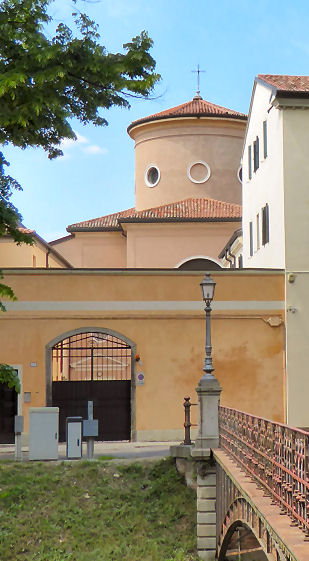 History Monastery built by monks moving from San Benedetto Vecchio in 1262 (see San Benedetto Vecchio entry above). Consecrated on March 6th 1267. Went into decline in the 15th century. In 1441 Pope Eugene IV gave it to another order, who improved it and in 1442 sold it to the Olivetans who rebuilt the cloisters in 1504 and the church in 1567, to designs by Francesco da Trevigi. The Olivetans thrived, until they were expelled by the Venetian republic in 1797. Suppressed in 1810. Nuns moved back in in the late 19th century, with the church being restored and rededicated in 1894. Lost art Saint Frances of Rome Restores the Sight of a Girl by Palma Giovane is in Eremitani Civic Museum. As is Saint Bernard Tolomei Helps the Infected by Domenico Maria Canuti, a Bolognese artist. And another one where the same saint helps the demon-afflicted. They are the two surviving panels from a cycle depicting the life of this saint created by the artist for this church between 1663 and 1664. |
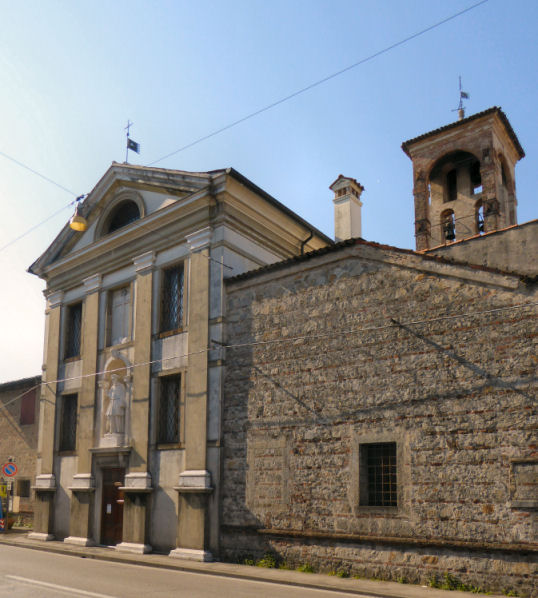 History HistoryPart of a complex built in the late 17th century. The order of the Virgin Franciscan Hermits in Padua was founded on August 10th 1612 by Sister Graziosa Zechini and was first located in the Pontecorvo area in three houses donated by Lucia Noventa, a wealthy widow. In 1615 the first chapel was built there. Noise and harassment, due to their proximity to two taverns, resulted in the order moving here, onto land provided by the patrician Malipiero family, purchased on February 26th 1680 with the approval of the bishop Gregorio Barbarigo. The community moved here on 11th May 1682 , with the church completed later, the first mass being sung on the 19th of March 1688. The complex survived the Napoleonic and Savoy suppressions, with no electricity until 1985. The church Baroque facade with four Doric pilasters supporting a pediment unusually containing, we are told, a thermal window. Over the door is a niche containing a statue of St. Bonaventure with the inscription SAN BONAVENTURA / AN. DO. MDCXCIII / ANTONIO ZANINI DETTO MANGRANDA / FECIT DI ANNI XVIII Campanile Odd in having a belfry of four high arches. Interior The seventeenth-century interior is characterized by vertical momentum, we are told. Over the high altar is St. Francis, St. Anthony, St. Bonaventure and St. Peter of Alcantara by Gaspare Diziani . On the side altars, to the right a Holy Family with Saints Zachary and Elizabeth by Pietro Damini, to the left an Immacolata by the circle of Francesco Zanella. Opening times |
|
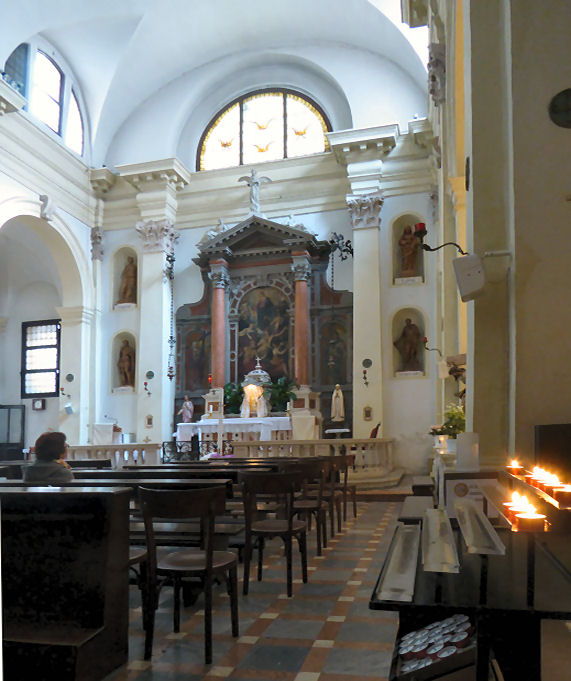 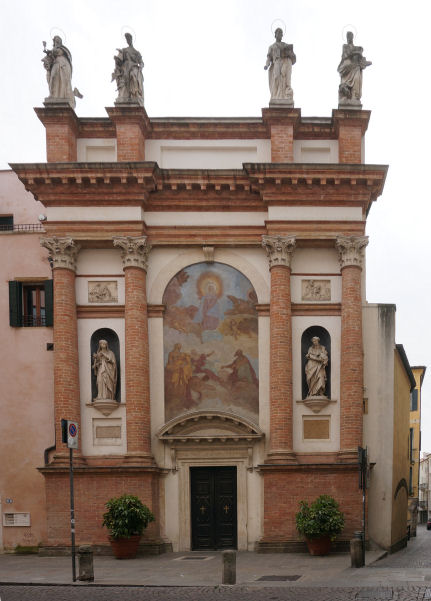 History Named for Saints Cantius, Cantianus, and Cantianilla, the martyrs of Aquileia, this church was already standing in 1034 as part of the monastery of Santo Stefano. Damaged by earthquake in 1117 and fire in 1174. This original church with three naves and an apse oriented to the east was rebuilt between 1595 and 1617, thanks to the legacy of Don Cesare Mantova, parish priest for 27 years. The completion of this work saw the presbytery now on the south side and the construction of a new facade overlooking Piazza delle Erbe. The church was finally consecrated on October 24th 1757 by Bishop Alessandro Papafava. Restoration in 1955.
The church
Interior |
||
|
San Clemente Piazza dei Signori |
||
|
Façade |
||
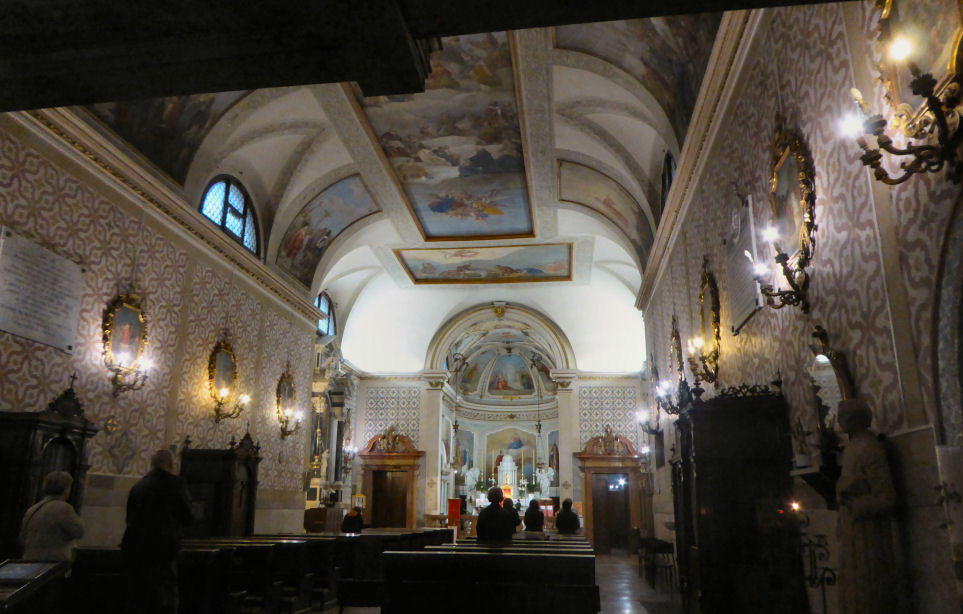  History A church and monastery were built in 1076. Legend has it that when the body of Saint Daniel, the early Christian martyr and one of Padua's patron saints, was bring translated from the church of Santa Giustina to the Cathedral when they got here the relics became too heavy to carry, with a darkness and thunder and lightning to force home the point, so the bishop built a church here to house them. Not much of this original chapel remains as it was almost completely rebuilt in the 18th century in late-Baroque style by Francesco Muttoni with more work on the façade and interior, neo-classical this time, in the 19th century. In 1771 the monastery was suppressed and became a private residence, but in 1948 Benedictine monks, exiled from a monastery in the former Yugoslavia, came here. Façade The façade is by Agostini Rinaldi with statues of local Saints Daniel and Justina, by Francesco Rizzi, in the niches. Interior Hall-like with an organ loft over the entrance. The shape of the apse derives from the romanesque church. The ceiling has 19th century Scenes From the Life of Saint Daniel by Sebastiano Santi. A Nativity altarpiece by Palma Giovane is reported. The Paduan illuminator Benedetto Bordon (c.1455-1530) is buried here.
Lost art
|
||
|
History Designated as Grande to avoid confusion with the church of San Francesco Piccolo, a church demolished by the 16th century, this church was built by Baldo Bonafario of Piombino and his wife Sibilla de Catto, along with a convent hospital, for the Franciscans. Work began in 1414 led by builder Nicholas Gobbo. In 1417 the church was built and work continued until mid-century. After the death of Bonafario the work was completed by his wife. This church was a single nave with chapels on the left and was consecrated on October 24th 1430. Due to the growing popularity of the Observant Friars Minori the church and monastery were enlarged at the beginning of the 16th century, under the direction of architect Lorenzo Pardi da Bologna. The chapels on the right were built and and the transept enlarged. The monastery was enlarged too, with a second cloister added. Fresco lunettes in the style of Squarcione in the loggia on the façade are very faded but were recently restored. Baldo and his wife Sibilla were buried here, as were Ferdinando Carlo Gonzaga-Nevers, the last Duke of Mantua, and Francesco Squarcione, a painter more famous for his pupils, including Mantegna, Zoppo and Crivelli, than his own talents. Suppressed in April 1810, becoming a parish church in the same year. In 1862 the floor was re-laid at the expense of many old tombstones. Total restoration in 1873. In 1914 the Franciscans returned to the church and part of the old convent. 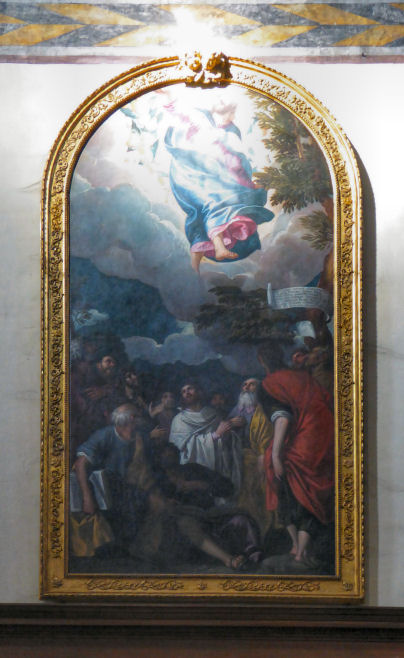 Interior Four side chapels each side of the wide nave with wide aisles, the transept not much deeper than the chapels but the right hand chapels are deeper and the right hand transept arm is marble-fenced off to enclose a red and white marble baroque extravagance by Giuseppe Sardi, built 1655/70. A long choir with an arch-shaped fresco of The Annunciation over the arch (see below right). The second chapel on the right is impressively frescoed inside (see below) and into the vault and over the arches of the aisle space in front, in 1523 by Girolamo dal Santo. An Ascension by Paolo Veronese originally to be found in the marble frame in the left transept chapel is now on the entrance wall high over the door (see right). The lower part with the Apostles was added in March 1625 by Pietro Damini after this part of the original was chopped off and stolen. The inscription inserted at the Fathers' request speaks of a 'nefarious theft from the highly wrought painting of the excellent Paolo Veronese' being restored by 'the felicitous pencil of Pietro Damino'. The Twelve Apostles in Prague's Olomouc Gallery is now thought to be the lost lower part. The parts were exhibited together at the Veronese e Padova exhibition in Padua in 2014. But another Assumption, in Dijon, is also a candidate for the top of the Prague painting, which they call Eleven Apostles.
|
|
|
|
|
||
|
History Opposite San Francesco Grande, this scuola was founded in 1414 for a lay confraternity, also using bequests from Baldo Bonafario and his wife Sibilla. Interior The scuola houses a cycle of 12 fresco panels of episodes from The Life of the Virgin made by Dario Varotari in 1579. It's an unusual sequence in that it avoids the usual scenes involving the life of Jesus. The panel in the photo (right) is the rarely-seen Death of Saint Joseph, a subject which became more popular in the 17th century. Opened by volunteers from Salvalarte, who don't have a website but are a branch of Legambiente. Scuola Opening times Thu & Sat 10.00-12.00 Thu-Sat 4.00-6.00* (*May-October 4.30-6.30)
|
|
|
|
History Also known as Santi Simone e Giuda this church was built from 1582 to 1586 by Vincenzo Scamozzi for the Theatines, an order founded by Saint Cajetan of Thiene, on the site of an old church called Saint Francesco Piccolo run by the Umiliati from whom the convent complex had passed when their order was suppressed by the Pope in 1571. Between 1578 and 1581 the Theatines had bought up more property, with the help of Bishop Federico Cornaro and with money from Alvise Cornaro. But the expansion work from 1629 failed to respect Scamozzi's plans, and baroque enrichments carried out at the behest of provost Raffaele Savonarola between 1692 and 1730 did not find universal approval. This work involved marble enrichments, three new altars and mannerist paintings. Suppressed by Napoleon in 1810, part of the monastery became the Palace of Justice in 1844 and the church became a parish church. Restoration in the 19th century. A fire which almost destroyed the monastery in 1929 left the church undamaged. The monastery is now a museum. Interior This was the first centrally-planned church built in Padua  . Inside it's aisleless tall and octagonal (or maybe
square with the corners chopped off) and decorated with the marble panels
and stucco typical of the 18th century. Sharp left as you enter, and down
some stairs, is the unserene Chapel of the Holy Sepulchre. The small Presbytery and separate
choir beyond are all marble and stucco too, but the large sacristy is much
plainer and more solemn. . Inside it's aisleless tall and octagonal (or maybe
square with the corners chopped off) and decorated with the marble panels
and stucco typical of the 18th century. Sharp left as you enter, and down
some stairs, is the unserene Chapel of the Holy Sepulchre. The small Presbytery and separate
choir beyond are all marble and stucco too, but the large sacristy is much
plainer and more solemn. Art highlights The dome has sixteen radiating trompe l'oeil fresco panels of Paradise by Parisian painter Guy-Louis Vernansal. Paintings include an oddly bright Deposition/Mourning by Varotari. A subtly mobile statue of the Virgin and Child is a survival from the Umiliati church by the Paduan sculptor Andrea Riccio (1470-1534) (see right). His real name was Andrea Briosco, but his nickname, Riccio, means curly. Two side chapels the right-hand one has The Transfiguration by Pietro Damini, The Presentation at the Temple of 1610 by Palma Giovane, is in the left-hand one. There's San Carlo Borromeo Saving a Child by Pietro Damini and works by Jacopo Bassano, Alessandro Maganza and GB Bissoni. There's an altarpiece by Vernansal too, depicting The Flagellation, in the Chapel of the Holy Sepulchre. Opening times 9.00-12.00, 4.00-6.00 |
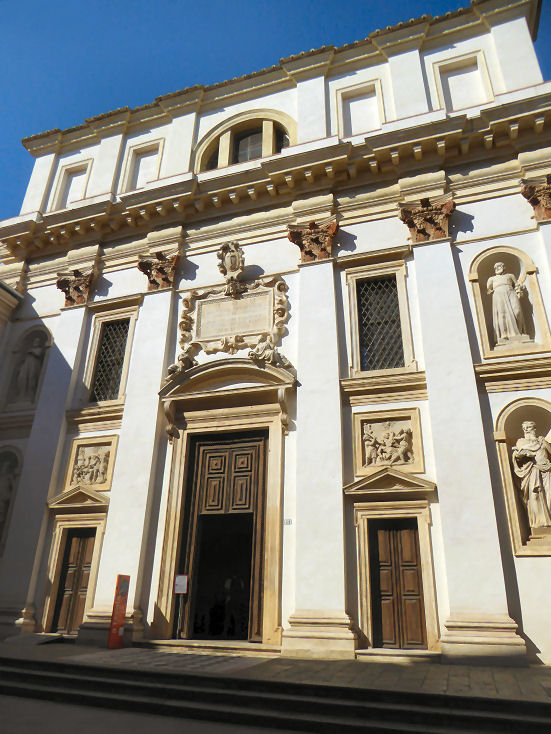  |
|
|
History The church of a monastery built in the early13th century by Benedictine monks, in an area know for the lushness of its vegetation, hence the name. In 1431 Pope Eugene IV gave the complex to his nephew Cardinal Antonio Correr , bishop of Ostia, who entrusted it in 1436 to a community of Lateran Canons who undertook a campaign of restoration and enlargement, entrusting the work to Lorenzo da Bologna and Giuliano da Porlezza. From the 15th to the 17th century the canons collected art and books, amassing a library that attracted the likes of Pietro Bembo. The collection of Marco Mantova Benavides, a renowned 16th century humanist, jurist and collector who is buried in the Ermitani, came here in 1711. In 1783 the Venetian Republic abolished the order of the Lateran Canons. The art went to the civic museum and the books to the Marciana Library. The church remained in use with the monastery serving as an orphanage, an Austrian barracks in 1847. The church was last used by Jesuits in 1866, and the complex now houses the Military Department of Forensic Medicine of Padua, the church remaining as a neglected and inaccessible wreck. 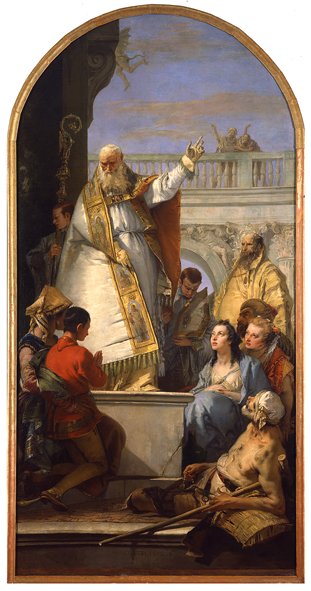 People buried in the church: sculptor Andrea Briosco, humanist and writer Lazarus Bonamico, Calfurnio Giovanni, medallist Giovanni da Cavino, painter Luca Ferrari, and Domenico Senno.
Exterior |

|
|
 History A church dedicated to the Twelve Apostles was built in 1174, replacing an older building which had been demolished to make way for the city walls. This building was itself demolished by order of James I of Carrara in 1320, after which construction of the current church began, consecrated on the 18th of October 1381. In the 17th and 18th century rebuilding altered the original east-west orientation. Suppressed in 1807 by Napoleon, on July 2nd 1815 the church was reopened as part of the new parish of Santa Maria dei Servi. It is currently used by the Greek-catholic community. The church was the seat of the Confraternita dei Pittori. On May 6th 1655 Bartolomeo Cristofori was baptized here, he being the inventor of the piano. The church The building is now oriented north-south, but you can still read the original east-west orientation of the external walls. The simple baroque facade, with two Ionic pilasters on each side, overlooks a fenced area which used to be a cemetery. The facade is topped with statues of the Virgin (at the top) St. Anthony (left) and St. Francis (right). On the wall are two plaques. One commemorates the reopening of the church in 1815, the other the baptism here of Bartolomeo Cristofori . Interior The below is all what I've read, not what I've seen. A Greek cross, the only one so shaped remaining in Padua. The side chapels were added in 1834. To the left, there was a painting of Sant'Espedito Martyr, which was stolen in 1997 and now replaced by a photo. Over the baroque 18th century altar in the chapel on the left is a 14th century fresco of The Virgin and Child, rediscovered during rebuilding in 1778 and restored by Francesco Zanon, and again restored in 1998, previously described as "in the manner of Giotto" and now attributed to Giusto de 'Menabuoi. Worryingly it is reported that the figures were crowned with silver tiaras donated in 1995. Further along on the left is a Pieta attributed to Bartolomeo Montagna. In the north transept is a 17th century painting of the Veronese school showing depicting Saint Benedict Handing his Monastic Rule to Saint Augustine. The marble high marble altar, decorated with semiprecious stones, is by Francesco Corbarelli and dates to 1667-68. The decoration and art here is all 17th century. The high altarpiece by Pietro Damini San Luca of The Virgin and the Patron Saints of Padua in which the Torlonga is also depicted. |
||
|
History The original church here may date back to the 6th or 7th century, being dedicated to the Archangels. Or it could be later as the first documented mention dates to 970. The Carrara lords helped in its rebuilding after a fire in 1390, which was caused by fighting between Francesco Novello's Paduans and Milanese soldiers, sent by the Visconti, who had besieged the nearby castle. This work, which involved expansion and painted decoration, was finished in 1397. In 1497 it passed to the congregation of Santo Spirito in Venice, in whose hands it remained until suppressed by the Pope Alexander VII in 1656. The Venetian Republic sold of its assets to pay for its war against the Ottoman Empire. After becoming the property of the Patriarch of Aquila the church went through the hands of various Venetian families in the 16th and 17th centuries. In 1792 much of the contents and art were removed, in 1808 it ceased to be the parish church and in 1812 it was closed. In 1815 Francesco Pisani, who lived in the palazzo next door, decided to demolish the church. All that was left was part of the nave and the chapel dedicated to the Virgin, which took on its present name at this time. Andrea Palladio was baptised in this church in 1508. Interior The current small space, once the chapel mentioned above, is full of vivid frescoes by Jacopo da Verona, a pupil of Altichiero. They were painted in 1397 and depict the Life of the Virgin, having been commissioned by Pietro de' Bovi, an official of the Ferrarasi mint.
Opposite the entrance, above the arch into the nave of the church, is a
three-panelled Annunciation. Below is Saint Michael, weighing
the souls of the dead, and The Banishment of Adam and Eve, possibly
a 16th century addition.
Lost art |
|
|
|
Interior
Lost art
|
 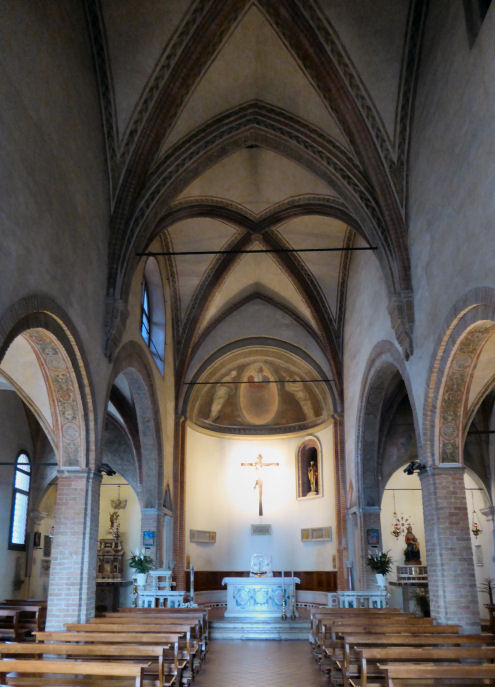
|
|
  History A church was known to have existed here in the 4th century, a rebuilding of 1026 followed destruction by Hun invaders around 900, and saw it passing to Benedictine nuns. Enlarged in the 14th century, substantial work in the 18th century and heavy restoration in the 19th and 20th centuries. Following the Napoleonic suppressions of 1809 the nuns remained for a few years and monks from San Prosdocimo came here too, bringing with them the body of Saint Eustochium, which is still here. Interior Has the appearance of being aisleless but the aisles are behind a wall on the left and doors on the right. The nave has two pairs of shallow plain side altars. The deep choir is a riot of dark but well-illuminated fresco decoration. The longer and higher enclosed left- hand aisle is dedicated to Saint Eustochium and has her remains and a fresco-decorated ceiling. The right-hand aisle has two spaces that are more like chapels.
Art highlights
Opening times |
||
 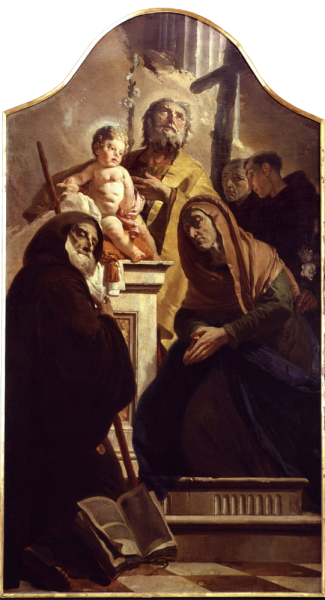 History A church with medieval origins and named for Saint Prosdocimus, the first bishop of Padua from the 4th century. Also known as the Duomo dei Militari, formerly the church of a monastery of Benedictine nuns, following Napoleonic suppression it was used as an army bakery and warehouse. Following restoration work it became a parish church for the military. After the earthquake of the 3rd of June 2012 the church was declared unsafe and closed, but following restoration work it was officially reopened on November 5th 2019 - the façade now looking much better than it did when I took the photo in 2017. Lost art Giambattista Tiepolo painted an altarpiece showing Saint Joseph with the Infant Jesus and Saints Francis of Paola, Anne, Anthony, and Peter of Alcantara (see left) for this church in c. 1730/35. It's now in the Accademia in Venice.
|
||
|
|
|
|
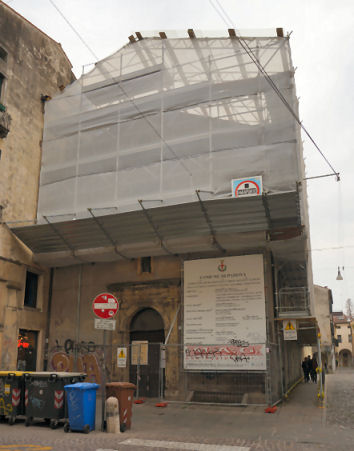 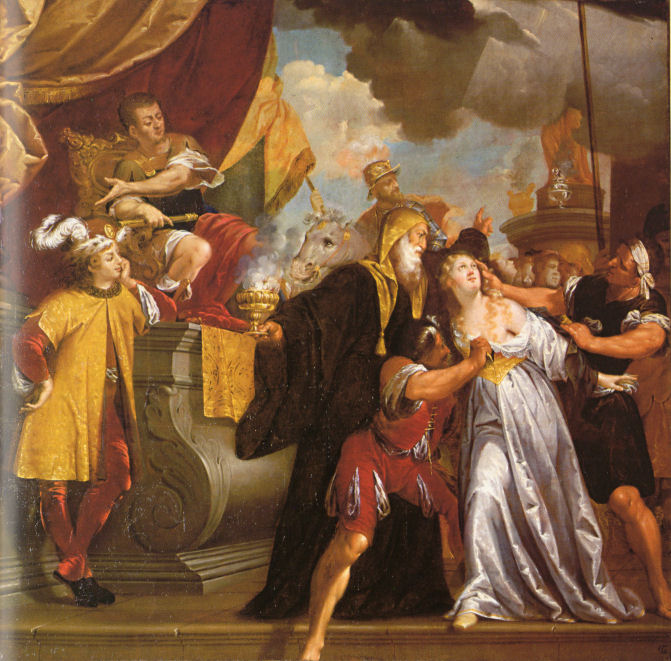 History A church is said to been here in the 12th century. First documented in 1202 as a parish church. This 13th century structure underwent restoration and expansion from the early 16th century, retaining its single-nave interior. After Napoleon the church lost its parish status and was later passed to the missionary Fathers of the Sacred Heart who lived here until 1939. It fell out of use during the Second World War and on October 7, 1948 was deconsecrated. It's art was moved to San Nicolò and the Episcopal Palace and the building was sold and later made into a garage, which it remained until the late 1990s. A portico was removed in the 20th century. Now abandoned and falling down, it was sold in 2011 to be converted to flats, but not much progress has been made, the scaffolding and graffiti visible in the photo having been there now for several years. The facade with renaissance doorway by Giovanni Maria Mosca - oriented to the east - was probably covered in fresco in the 16th century. Interior The interior has been gutted. Campanile A Romanesque bell tower of the 13th century. Lost art Paintings by Francesco Minorello, a pupil of Luca Ferrari, depicting the life of Saint Agnes (St Agnes refusing Gifts and the Martyrdom of Sant'Agnese at the Gallows) are now in the Episcopal Palace. Over other altars were works by Giulio Cirello, another pupil of Ferrari - St Agnes Urged to Marry the Son of the Prophet (aka St Agnes Beaten by the Roman Prefect) (see left) and St Martha as a Nun Sprays Holy Water on a Dragon. The former, at least, is also in the Episcopal Palace, and was restored in 2000. An altarpiece of 1777 by Giandomenico Tiepolo of the Virgin and Child with Saints Francesca Romana and Eurosia, formerly on the first altar on the right, is now in San Niccolò. |
||
|
Sant'Andrea Via Sant'Andrea |
||
|
History Dedicated to Saint Andrew the Apostle, the original church here was built before 1130 and in 1640 was completely rebuilt. In 1875 the single nave was transformed into a nave and aisles separated by Corinthian columns, with decoration reflecting contemporary taste. The work was finished in 1884 and the 'unfashionable' art previously in the church was dispersed. Some restoration in the 1920s, the church was consecrated on October 17th 1941. Paduan Arrigo Boito, writer of libretti for Verdi and lover of Eleonora Duse, was baptized here on 19 March 1842. The building was damaged by the earthquake of the 3rd of June 2012.
Interior Lost art |
|
|
continued on page 2
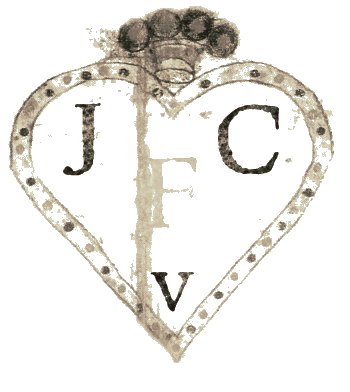
Home
Cannaregio ::
Castello :: Dorsoduro ::
Giudecca :: San Marco ::
San Polo :: Santa Croce ::
The Islands :: Demolished